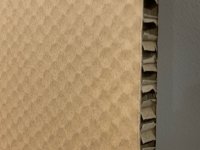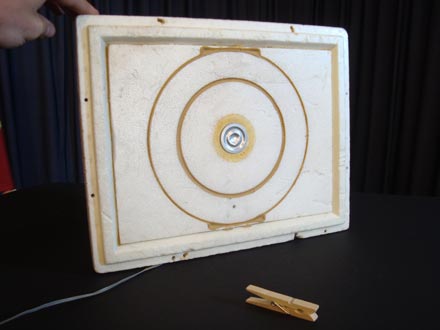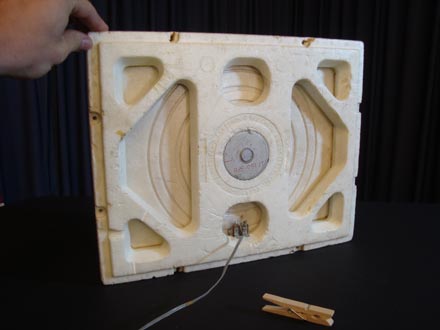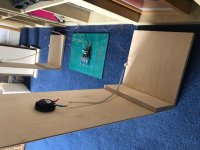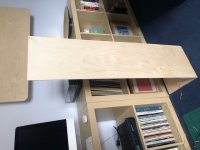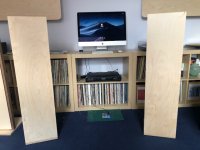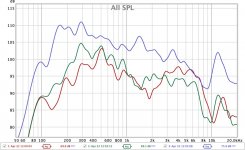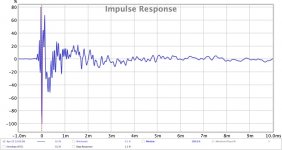I see this decrease in amplitude when I use a laser reflection off a small mirror place on the panel. The further away from the exciter the less the amplitude until the piston effect kicks in about 160-150 Hz.
Interesting experiment tagis, can you explain a little more? Especially the part about the piston effect.
Are you saying that if you play a tone well above 150 Hz, then you see smaller amplitudes the farther you get from the exciter, but if you play 150 or less, then the amplitude doesn't get smaller as you get farther from the exciter?
I must admit that I'm wondering more and more lately how much modal i.e. standing wave DML type behavior my panels are actually doing. If they were truly modal it feels like the frequency response would be more sensitive to exciter placement than it seems to be. Just a few days ago I was trying really hard to drive the 1,3 mode on a 12" x 48" plywood panel, by placing multiple exciters on the anti-nodes for that specific mode. I tried a bunch of different arrangements but none of them had anything like the effect I would have expected from panels that were truly modal.
Thanks,
Eric
Hi Eric,
Here is a schematic of the basic setup. The laser will have a different amplitude between A and B that smaller distance as the mirror is moved from position 1 to 2 ect. When the tone increases from 150 Hz onwards till about 8KHz one can see a the motion drop in an exponential rate between the mirror positions.
After 8KHz It is difficult to see any laser motion I have the screen 1 meter away to try and calculate the panel motion I will post my data tomorrow. With the frequency 150Hz and below to about 37 Hz I see a uniform piston motion At 37 Hz and below I start to see modulated low frequency modulation in addition to the piston motion. I hope to use a motion camera to capture this effect.
Cheers
Steve
Here is a schematic of the basic setup. The laser will have a different amplitude between A and B that smaller distance as the mirror is moved from position 1 to 2 ect. When the tone increases from 150 Hz onwards till about 8KHz one can see a the motion drop in an exponential rate between the mirror positions.
After 8KHz It is difficult to see any laser motion I have the screen 1 meter away to try and calculate the panel motion I will post my data tomorrow. With the frequency 150Hz and below to about 37 Hz I see a uniform piston motion At 37 Hz and below I start to see modulated low frequency modulation in addition to the piston motion. I hope to use a motion camera to capture this effect.
Cheers
Steve
Attachments
Burntcoil.
I was just looking at your post 1452 post,and was a little puzzled because the cm1 speaker has the same HF roll off ?
If you place the microphone 2inches in front of the exciter central area ,Do you still get the 10k roll off ?
I'm just trying to figure out what is going on,is this a panel,exciter,attachment,microphone,or measurement problem?
Hopefully if measured very close to the exciter hf should improve ?
Steve
I was just looking at your post 1452 post,and was a little puzzled because the cm1 speaker has the same HF roll off ?
If you place the microphone 2inches in front of the exciter central area ,Do you still get the 10k roll off ?
I'm just trying to figure out what is going on,is this a panel,exciter,attachment,microphone,or measurement problem?
Hopefully if measured very close to the exciter hf should improve ?
Steve
Hi Steve,
That was measuring the tall panels in Ealing not the panels I have here. The only EQ in that case was to the bass, I has not looked at the top end at all at that point.
It was also using an iPhone App not using REW with a decent mike.
I will do some measurements here using REW and post those tomorrow.
Burnt
That was measuring the tall panels in Ealing not the panels I have here. The only EQ in that case was to the bass, I has not looked at the top end at all at that point.
It was also using an iPhone App not using REW with a decent mike.
I will do some measurements here using REW and post those tomorrow.
Burnt
Burntcoil.
If you could remind me of the size and thickness of the panel plus coil and exciter size,watts,I will try and match materials as close as possible so as we can compare measurements,I do have a measurement microphone but no way of connecting it to my computer,so it'll be deq display only.
But obviously we will be using our ears mostly ,as that is the most important.
Even if we don't get a good hf response we can try a couple of tricks to see if we can improve the listening enjoyment,one can only hope they work?
And my deq uses pink noise, is it possible to match?
If you do get a better close hf response,could you also measure at say about 2ft distance so as to give you room to move around and test in real time,we are only interested at this time in what is happening around the 2 or so inches of the exciter area.
All the best.
Steve.
If you could remind me of the size and thickness of the panel plus coil and exciter size,watts,I will try and match materials as close as possible so as we can compare measurements,I do have a measurement microphone but no way of connecting it to my computer,so it'll be deq display only.
But obviously we will be using our ears mostly ,as that is the most important.
Even if we don't get a good hf response we can try a couple of tricks to see if we can improve the listening enjoyment,one can only hope they work?
And my deq uses pink noise, is it possible to match?
If you do get a better close hf response,could you also measure at say about 2ft distance so as to give you room to move around and test in real time,we are only interested at this time in what is happening around the 2 or so inches of the exciter area.
All the best.
Steve.
Last edited:
The panels here?
600mm by 1200 mm by 4mm Poplar ply three layers- cheap as chips grade.
I use Dayton Audio DAEX32EP-4 Thruster 32mm Exciter Speaker 40W 4 Ohm
I can dial up Pink Noise for the REW test and limit the FR to specific parts of the range if that helps?
Mike location will be attempted by open frame chair, sticky tape and lots of swearing, OK?
Thank you for the ideas and experimental help, much appreciated
Burnt
600mm by 1200 mm by 4mm Poplar ply three layers- cheap as chips grade.
I use Dayton Audio DAEX32EP-4 Thruster 32mm Exciter Speaker 40W 4 Ohm
I can dial up Pink Noise for the REW test and limit the FR to specific parts of the range if that helps?
Mike location will be attempted by open frame chair, sticky tape and lots of swearing, OK?
Thank you for the ideas and experimental help, much appreciated
Burnt
. The problem I see with current models is it assumes a homogenous material and most panels that the DML community is using is not homogenous. So I don't see reflections playing a major roll what am I missing??
Cheers
Steve
I agree with Msr Veleric this is a very interesting experiment.
On the materials being used I think I am right in saying there are two groups.
XPS/EPS is more or less homogenous. There are irregularities at a very small scale with open cell walls or cell boundaries but these average out pretty quickly
Ply with uneven layers is anisotropic as Eric has pointed out before and has a significant effect on stiffness along the two axis. This in itself is an area that might be worth more experimentation.
Burnt
Burntcoil.
I suddenly thought ,I'd better explain why I'm only interested in the 2or so inches of the exciter ring area.
This will hopefully show the full direct output of the coil ,which is what we are most interested in ,and not so much the panel response, and usually gives a good response from 20hz to 20k ish ,we hope.
I presume you have noticed the higher output in this area which tectonic call the primary drive area, I believe.
It helps (please bear with me)if you think of this area as having a 2inch full range driver,such as a Jordan or bandor(which I have)and separate it from the panel in your mind,so that you have two speaker ,one dml and one direct radiator in the middle.
This 2inch unit is the one I want to play around with,I treat heavy ply different to light eps and 2mmm panels ,so this should be interesting,hope it works.
Steve
I suddenly thought ,I'd better explain why I'm only interested in the 2or so inches of the exciter ring area.
This will hopefully show the full direct output of the coil ,which is what we are most interested in ,and not so much the panel response, and usually gives a good response from 20hz to 20k ish ,we hope.
I presume you have noticed the higher output in this area which tectonic call the primary drive area, I believe.
It helps (please bear with me)if you think of this area as having a 2inch full range driver,such as a Jordan or bandor(which I have)and separate it from the panel in your mind,so that you have two speaker ,one dml and one direct radiator in the middle.
This 2inch unit is the one I want to play around with,I treat heavy ply different to light eps and 2mmm panels ,so this should be interesting,hope it works.
Steve
Vive le France! You might get some in the US soon Eric, Poplar is farmed as a sustainable source over here and is gaining in popularity.
You might say it is getting quite... poplar.... harr harr !
I’ve just ordered 2 panels of 3mm aircraft grade birch, each 2 by 4 feet from the aircraft spruce website, since they deliver world wide.
I hope it doesn’t prove too thin !
Cardboard Honeycomb?
I think I just scored a major find on a potential DML panel material. I got a large mirror delivered the other day. The box had a 76in x 32in x 15mm thick brown paper faced honeycomb core material to protect the mirror inside the box. It is huge, very stiff and light weight. If we like the sound of paper cone drivers, this just might be the thing. I want a pair of stereo panels. Should I cut length wise for two 76in tall x 16in wide panels for a "Tall Brunette" speaker? Or the other way at 38in x 32in pair of panels? I think the tall ones will get deeper bass from what I have read. Has anyone else tried cardboard honeycomb?
Closeup:
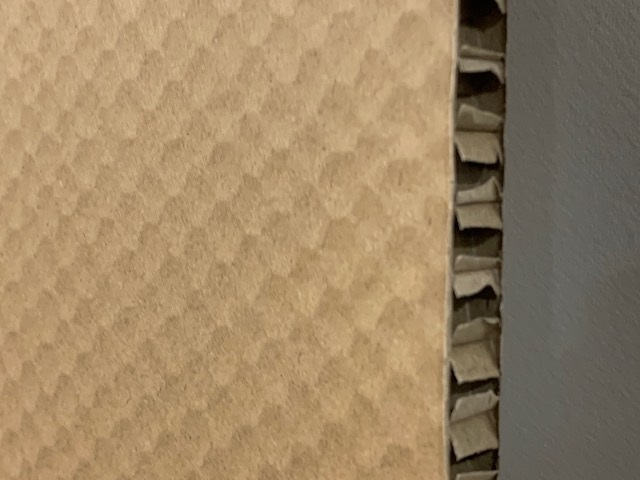
I think I just scored a major find on a potential DML panel material. I got a large mirror delivered the other day. The box had a 76in x 32in x 15mm thick brown paper faced honeycomb core material to protect the mirror inside the box. It is huge, very stiff and light weight. If we like the sound of paper cone drivers, this just might be the thing. I want a pair of stereo panels. Should I cut length wise for two 76in tall x 16in wide panels for a "Tall Brunette" speaker? Or the other way at 38in x 32in pair of panels? I think the tall ones will get deeper bass from what I have read. Has anyone else tried cardboard honeycomb?
Closeup:
Attachments
how different is this from DML's The ‘70s Plastic Planar Phenomenon ?
Last edited:
I think you'd get a better response with something closer to a square, and two similar but different dimensions. This seems to me, on listening, to provide a better distribution of modes.
I think Burnt Coil had some revelations about tall skinny panels as being best.
@xrk971 and @Jamu,
Thanks for the prompt xrk971
On tall panels I have found the following.
From 100Hz out to 20kHz with EQ I have found the performance to be just as good at the 'conventional' golden section or silver section ratios. Combined with a decent subwoofer you get wonderful performance for the money, in my view , having lived with ESL's for years, the sound is on par but with better rendition of instrument timbre and better attack.
Nothing controversial about that and it makes for a very elegant and WAF friendly solution.
However, and this is the controversial bit, when building a pair of tall panels I discovered that two pairs I built had a much better bass response than panels with the conventional ratios.
BUT...
This needs careful caveating, the detail is important. I have only had this additional bass result with three layer Birch ply. As Veleric has pointed out, this material is highly anisotropic- it is much stiffer in in one axis than in the other axis at 90 degrees to the first. This is probably a big factor in the performance I get from these panels. Secondly, having used a number of mathematical models to calculate the panel eigenfrequencies I find that the simpler models for a beam rather than the models used to calculate a panel to give results closer to the performance I get in the bass. The following is highly speculative and not to be relied on, but I think it possible that the tall ratio panels transition from a DML mode to something more like a vibrating beam at lower frequencies.
None of this has been proven yet! Once the lock-in has stopped in France I plan to run some experiments using various ratio panels measuring the results with REW to try to bed this down once and for all.
Having said that, other posters have reported good bass performance from XPS/EPS panels with similar tall ratios but, I am not aware of anyone doing a side by side comparison yet. It's a work in progress.
So, used with EQ with a subwoofer with an XO at circa 100-200Hz you will get terrific performance from panels with ratios 1:3.8 and 1:4. Experiment with where you place the exciter on this ratio of panel but I find the best position to be just off the centre line on the long axis and about a third of the way up from the base. Plan to do this and, if you find like me the bass goes deeper than expected, you can dial back the subwoofer performance to taste.
Pictures are of the simplest tall panels
Burnt
Thanks for the prompt xrk971
On tall panels I have found the following.
From 100Hz out to 20kHz with EQ I have found the performance to be just as good at the 'conventional' golden section or silver section ratios. Combined with a decent subwoofer you get wonderful performance for the money, in my view , having lived with ESL's for years, the sound is on par but with better rendition of instrument timbre and better attack.
Nothing controversial about that and it makes for a very elegant and WAF friendly solution.
However, and this is the controversial bit, when building a pair of tall panels I discovered that two pairs I built had a much better bass response than panels with the conventional ratios.
BUT...
This needs careful caveating, the detail is important. I have only had this additional bass result with three layer Birch ply. As Veleric has pointed out, this material is highly anisotropic- it is much stiffer in in one axis than in the other axis at 90 degrees to the first. This is probably a big factor in the performance I get from these panels. Secondly, having used a number of mathematical models to calculate the panel eigenfrequencies I find that the simpler models for a beam rather than the models used to calculate a panel to give results closer to the performance I get in the bass. The following is highly speculative and not to be relied on, but I think it possible that the tall ratio panels transition from a DML mode to something more like a vibrating beam at lower frequencies.
None of this has been proven yet! Once the lock-in has stopped in France I plan to run some experiments using various ratio panels measuring the results with REW to try to bed this down once and for all.
Having said that, other posters have reported good bass performance from XPS/EPS panels with similar tall ratios but, I am not aware of anyone doing a side by side comparison yet. It's a work in progress.
So, used with EQ with a subwoofer with an XO at circa 100-200Hz you will get terrific performance from panels with ratios 1:3.8 and 1:4. Experiment with where you place the exciter on this ratio of panel but I find the best position to be just off the centre line on the long axis and about a third of the way up from the base. Plan to do this and, if you find like me the bass goes deeper than expected, you can dial back the subwoofer performance to taste.
Pictures are of the simplest tall panels
Burnt
Attachments
Last edited:
Burntcoil.
I suddenly thought ,I'd better explain why I'm only interested in the 2or so inches of the exciter ring area.
This will hopefully show the full direct output of the coil ,which is what we are most interested in ,and not so much the panel response, and usually gives a good response from 20hz to 20k ish ,we hope.
I presume you have noticed the higher output in this area which tectonic call the primary drive area, I believe.
It helps (please bear with me)if you think of this area as having a 2inch full range driver,such as a Jordan or bandor(which I have)and separate it from the panel in your mind,so that you have two speaker ,one dml and one direct radiator in the middle.
This 2inch unit is the one I want to play around with,I treat heavy ply different to light eps and 2mmm panels ,so this should be interesting,hope it works.
Steve
Hi Steve,
I have been able to complete some initial tests on the large panels here in Varaize.
I include two pictures, the first is frequency response, the second is an impulse response.
I measured a single panels FR with the mike in three positions. 1 directly over the exciter ( Blue trace) ,2 at the left hand corner of the panel (Green trace) and 3 at the right hand corner ( Red trace). In each case the mike was 50mm/ 2 inches from the panel surface. The response is raw, without EQ, and with the subwoofer turned off.
I think I have been successful in making sure the response is properly gated to make sure that only the output of the exciter and panel is captured and excludes room effects. It is the first time I have tried this so if anyone thinks I have got this wrong i would be happy to hear that.
As you can see the exciter output is around 5dB higher over most of the frequency range. There are variations in output from the panels at each corner, the divergence in output between exciter and corners at 1.5kHz to 2 kHz is interesting.
I suspect that there is similar variation in output across the panel and what you get at 4M away, my listing position, is a summation of all these differences. In case anyone is alarmed by these results, if you look at what happens to a different areas of a cone at different frequencies, similar variations occur.
Please let me know if this is useful Steve
Best
Burnt
Attachments
I think I just scored a major find on a potential DML panel material. I got a large mirror delivered the other day. The box had a 76in x 32in x 15mm thick brown paper faced honeycomb core material to protect the mirror inside the box. It is huge, very stiff and light weight. If we like the sound of paper cone drivers, this just might be the thing. I want a pair of stereo panels. Should I cut length wise for two 76in tall x 16in wide panels for a "Tall Brunette" speaker? Or the other way at 38in x 32in pair of panels? I think the tall ones will get deeper bass from what I have read. Has anyone else tried cardboard honeycomb?
Closeup:
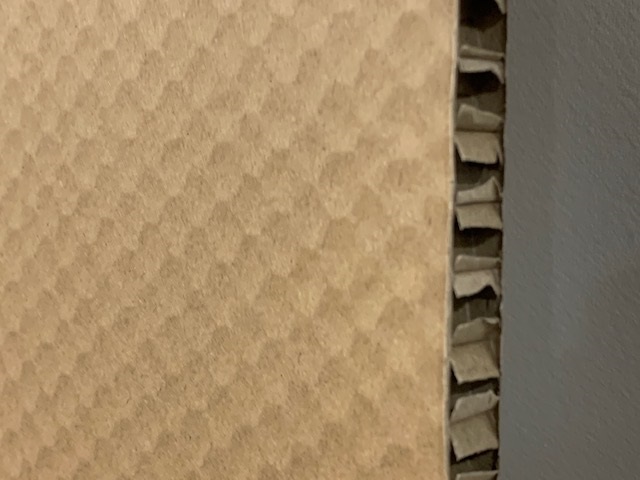
Hi xrk971
that's a wonderful find and a very good idea. I've this in mind, since burnt has made those long and tall DML's. Probably one side coated with veneer could be an option.
Thank you all for your work and experiences and especially to xrk for pointing to that thread. I appreciate it a lot!!!
- Home
- Loudspeakers
- Full Range
- A Study of DMLs as a Full Range Speaker
